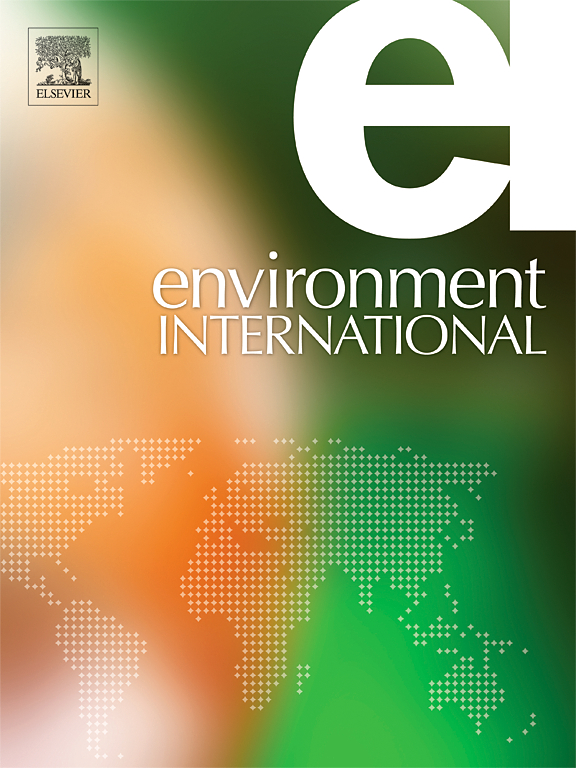Spatially resolved analysis of speciated VOC emissions and their contributions to secondary pollutant formation: a comparative assessment of anthropogenic and biogenic sources in China
IF 9.7
1区 环境科学与生态学
Q1 ENVIRONMENTAL SCIENCES
引用次数: 0
Abstract
Volatile organic compounds (VOCs) significantly impact ozone (O3) and particulate matter (PM2.5) formation, requiring spatially resolved emission and reactivity assessments for air pollution control. Here, we developed a 27 km-grid speciated VOC emission inventory involving both anthropogenic and biogenic sources over mainland China in 2021, by combining the traditional emission factor method with refined spatial allocation method. Total VOC emissions reached 66.7 Tg, with biogenic sources contributing 65.0 % and anthropogenic sources 35.0 %, and their emission intensities varied from 0 to 684.9 t/km2, peaking in South (24.7 t/km2) and East China (23.8 t/km2), while lowest in the Northwest (1.7 t/km2). Then, the speciated VOC emissions were further combined with their OH reaction rates and secondary organic aerosol (SOA) yield, to respectively achieve their OH reactivity (OHRE) and SOA formation potential (SOAPE). The national average OHRE, calculated across all grid cells in China, for VOCs was 3028.9 s−1, far exceeding the counterparts for inorganic components, while the national mean SOAPE was 0.3 t/km2, contributing 38.3 % to PM2.5 emission. Both OHRE and SOAPE displayed significant spatial heterogeneity, with OHRE decreasing from south to north, peaking in South China (11016.0 s−1) and reaching its lowest in the Northwest (602.6 s−1). In contrast, SOAPE showed less regional variation but was highest in urban agglomerations, including the Pearl River Delta (1.6 t/km2), Yangtze River Delta (1.3 t/km2), and Beijing-Tianjin-Hebei (0.6 t/km2). This study is the first to quantify the spatial variability of OHRE and SOAPE using a gridded emission inventory, uncovering differences between anthropogenic and biogenic contributions and supporting targeted regional pollution control strategies.


特定挥发性有机化合物排放的空间解析及其对二次污染物形成的贡献:中国人为和生物源的比较评估
挥发性有机化合物(VOCs)显著影响臭氧(O3)和颗粒物(PM2.5)的形成,需要空间分辨的排放和反应性评估来控制空气污染。本文采用传统排放因子法与精细空间分配法相结合的方法,建立了中国大陆地区2021年27 km栅格的人为和生物源VOC排放清单。总挥发性有机化合物(VOC)排放量为66.7 Tg,其中生物源贡献65.0 %,人为源贡献35.0 %,排放强度变化范围为0 ~ 684.9 t/km2,南方最高(24.7 t/km2),华东最高(23.8 t/km2),西北最低(1.7 t/km2)。然后,将指定VOC排放量与它们的OH反应速率和二次有机气溶胶(SOA)产率结合起来,分别得到它们的OH反应活性(OHRE)和SOA形成势(SOAPE)。全国VOCs平均OHRE为3028.9 s−1,远超无机组分;全国SOAPE平均值为0.3 t/km2,对PM2.5排放的贡献率为38.3 %。OHRE和SOAPE均表现出显著的空间异质性,OHRE由南至北递减,在华南最高(11016.0 s−1),在西北最低(602.6 s−1)。SOAPE区域差异较小,但以珠三角(1.6 t/km2)、长三角(1.3 t/km2)、京津冀(0.6 t/km2)城市群最高。本研究首次使用网格化排放清单量化了OHRE和SOAPE的空间变异性,揭示了人为和生物因素之间的差异,并支持有针对性的区域污染控制策略。
本文章由计算机程序翻译,如有差异,请以英文原文为准。
求助全文
约1分钟内获得全文
求助全文
来源期刊

Environment International
环境科学-环境科学
CiteScore
21.90
自引率
3.40%
发文量
734
审稿时长
2.8 months
期刊介绍:
Environmental Health publishes manuscripts focusing on critical aspects of environmental and occupational medicine, including studies in toxicology and epidemiology, to illuminate the human health implications of exposure to environmental hazards. The journal adopts an open-access model and practices open peer review.
It caters to scientists and practitioners across all environmental science domains, directly or indirectly impacting human health and well-being. With a commitment to enhancing the prevention of environmentally-related health risks, Environmental Health serves as a public health journal for the community and scientists engaged in matters of public health significance concerning the environment.
 求助内容:
求助内容: 应助结果提醒方式:
应助结果提醒方式:


